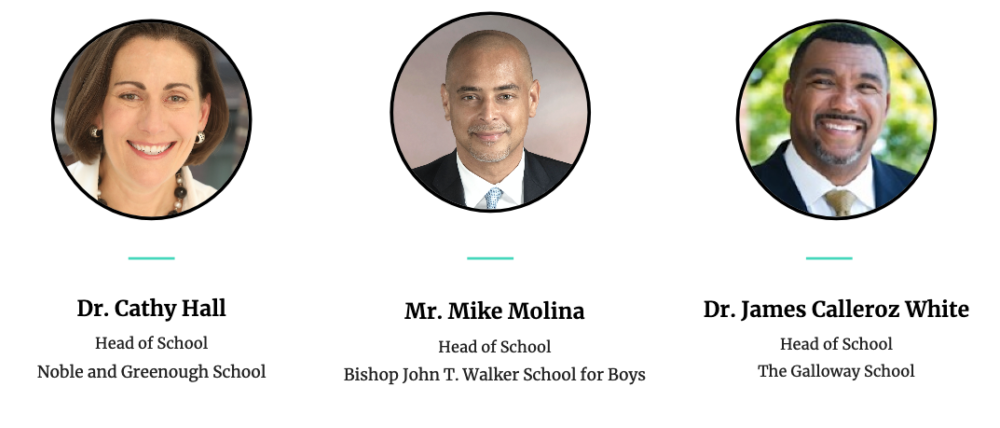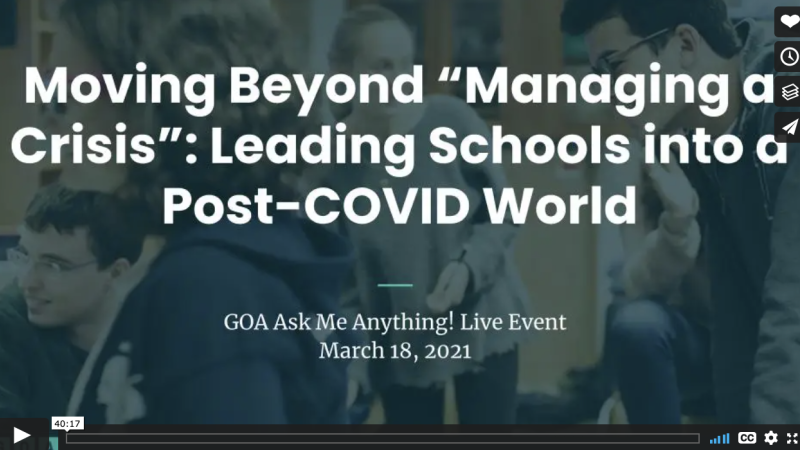Four Pathways for School Leaders Preparing for a Post-COVID World
There’s a lot to be hopeful for as we look ahead to the future of schools. Without a doubt, educators are exhausted from over a year of providing rapid responses to an ever-changing situation in our schools. Yet, in the effort to respond, adapt, and innovate, there’s so much we’ve learned about our students, our schools, and education writ large.
Recently, GOA hosted an Ask Me Anything! Live Event,“Moving Beyond ‘Managing a Crisis’: Leading Schools into a Post-COVID World,” in which three school leaders reflected on COVID-19’s impact on schools. Hosted by GOA’s Executive Director, Michael Nachbar, the AMA panel featured Cathy Hall (Head of School, Noble and Greenough School), Mike Molina (Head of School, Bishop John T. Walker School for Boys), and James Calleroz White (Head of School, The Galloway School). The leaders spoke to how managing a crisis are informed their strategies around programs, operations, wellness, and culture, as well as some of their hopes for what they’ll be able to return back to.
You can view the full recording of the AMA below. What follows is a list of key takeaways and themes that emerged from the conversation.
Recording: Leading Schools into a Post-Covid World
Four Pathways for School Leaders Preparing for a Post-COVID World
Ensure Your School is a Community Hub
After this past year, it became clear that schools are much more than teaching and learning organizations: they are hubs for a community. Through the experience of leading through COVID, the panelists reflected on how they were able to provide greater access to families and community members by leveraging video conferencing tools such as Zoom. Families who otherwise might not be able to attend events or meetings during the school day on campus could engage directly with their schools in real-time or access recordings later. This has had profound implications for increasing family engagement, improving equity and access, and providing a sense of belonging. The panelists cannot envision a scenario in which they’ll never record a school meeting again.
At the same time, the panelists recognized that their communities have experienced real trauma and despair. Cathy Hall noted, “I underestimated the personal loss for parents,” when it came to the social network that school communities provide. While video conferencing has done wonders in providing greater access, it hasn’t replaced the connections forged from drop-off and pick-up, sitting in the audience of the school play, or standing on the sidelines at games. The panelists expressed that some of the priorities for “returning to normal” will include dedicating resources and time to rebuilding and repairing relationships.
Recognize this Slingshot Moment for Strategic Innovation
James Calleroz White noted that as a result of COVID, “Our schools have shown us that we can pivot on a dime and move and change things at a much quicker pace than we’re used to.” Initiatives that would take years to roll out, such as schedule design or changes to assessment practices, were put into action quickly and then modified responsibly and responsively. Schools have discovered a sense of agility that cannot be walked back, and it will have profound implications for how things get done at schools in the future.
At the same time, White noted that COVID also “gave us permission to stop doing.” Pre-COVID there was a tendency in schools to continue to add and never subtract when it came to initiatives and asks of faculty and staff. The past year has afforded schools the opportunity to center their mission, concretize their priorities, and refine and shed. The result is strategic innovation.

The three panelists agreed that their priorities moving beyond COVID-19 would be relationships and wellness.
Meet Each Person Where They Are
As a result of the various innovations schools had to make in response to COVID, we increased our capacity to meet each person where they are. Mike Molina notes that because of online and hybrid learning, “We have so much more information than we had before. We have parents in the classroom. We have teachers in the home.” Ultimately, we can use this information to innovate responsibly, improve our programming, and serve our students and communities more responsively. As Cathy Hall noted, this has already manifested itself at her school where students are doing much better with counseling over a Zoom session rather than in-person. The potential for multiple pathways and increased access are great.
This idea of “meeting each person where they are” can also extend quite literally in the realms of program and operations. A question on Mike Molina’s mind is given the infrastructure schools have built as a result of COVID, “How might we be able to expand and serve people who aren’t in our immediate vicinity?” when it comes to enrollment. Cathy Hall noted that there’s potential to support ongoing remote work for faculty who need that option because of personal or family circumstances. Indeed, as many other industries look to making remote work a regular facet of their experience, it will be interesting to see the direction that schools take when it comes to their own remote workforce.
Faculty Wellness Must Be Prioritized
Much has been written about the need for schools to support student wellness concerns during the past year. As James Calleroz White observed, health and wellness were “something we always claimed we didn’t have time for,” and yet as a result of COVID, schools have been able to prioritize “being intentional not just about what we teach, but how we teach it.”
Yet, ongoing work needs to be done in the realm of faculty wellness. The panelists expressed that the province of school leaders is centering the question of where does health and wellness sit in our schools for faculty. Looking ahead to next year, James Calleroz White’s team at Galloway is looking at the schedule to intentionally plan for and materialize opportunities for faculty to reflect, restore, and renew together.
Indeed, this past year has been fraught for teachers’ social-emotional wellness in not only dealing with the threat of the virus, social isolation, and the challenges of transitioning to distance learning, but also in being villainized in narratives around school reopenings. As Cathy Hall noted that “Our community is at polar ends: our faculty have legitimate anxieties and safety concerns that our families can’t understand.”
For the panelists, this is where the art of leadership has had to come into play in striking the balance between when to insulate faculty and when to supportively move them along. Mike Molina articulated a useful framework in driving action by distinguishing between a concern and a worry: “Concerns are specific, related to something we can resolve. A worry is a low hum of challenge. When someone is worried, they need TLC. My role is to be a pastor when it’s a worry, a field marshal when it’s a concern.” Leading faculty into a post-COVID world is going to require applying an ethic of care in which a leader can discern when to protect and when to push.
For more considerations about education in a post-COVID world, read these articles:
- Six Ideas School Leaders Want to Keep Post-COVID
- Eight Predictions for Education in 2021
- Competency-Based Learning: A Long-Term Teaching Strategy for Online and Hybrid Learning
Are you interested in enhancing your leadership skill set? GOA has just announced its Summer Leadership Institute, which will run from June 14-18, 2021. Explore all of GOA's upcoming professional learning offerings as well as its strategic consulting services.

